Performance Effects of Algorithmic Elements in Selected MANETs Routing Protocols
Volume 5, Issue 3, Page No 62-71, 2020
Author’s Name: Mutuma Ichaba1,a), Felix Musau2, Simon Nyaga Mwendia1
View Affiliations
1KCA University, Faculty of Computing and Information Management, 00200, Kenya
2Riara University, School of Computing Sciences, 00100, Kenya
a)Author to whom correspondence should be addressed. E-mail: icmutuma@gmail.com
Adv. Sci. Technol. Eng. Syst. J. 5(3), 62-71 (2020); ![]() DOI: 10.25046/aj050309
DOI: 10.25046/aj050309
Keywords: Mobile Ad Hoc Networks (MA-NETs), Routing Protocols, Reactive, Proactive, Hybrid, Location-Aided
Export Citations
Over time, several routing protocols have been suggested for use in Mobile Ad Hoc Networks (MANETs). Because of availability of so many MANETs routing protocols, network engineers and administrators face difficulties in identifying an appropriate routing protocol for a particular scenario. This challenge results from the unavailability of adequate technical analytic studies designed to examine the effects of various algorithmic aspects of the available routing protocols. Availability of such studies are critical in routing identification and selection process, thus making the work of network engineers and administrators more manageable. Moreover, such studies can guide future development and implementation of MANETs routing protocols. Although there are studies meant to gauge comparative performance of various routing protocols, very little or no attempts have made to ascertain the effects of nodal topological position-information data on overall performance. This study used purposive sampling to select the routing protocols for study, literature review process to review and critique the available studies and simulation to determine the effects of nodal position-location information. Largely, MANETs routing protocols are either characterized as reactive, proactive, hybrid or location-aided. Through purposive sampling, we selected. protocol Zone Routing Protocol (ZRP) to represent hybrid routing whereas Ad hoc On-Demand Distance Vector routing (AODV) to represent reactive routing. Destination-Sequenced Distance Vector routing (DSDV) was selected purposively to represent proactive while Greedy Perimeter Stateless Routing (GPSR) was selected purposively to represent location-assisted routing. Initial elementary scalar variables of data throughput, packet drop rates, average delay and the number of packets received are simulated on NS2—to simulate ZRP and OMNET++–to simulate AODV, DSDV and GPSR. Simulation data from the two simulators was analyzed on RapidMiner. Simulation results indicate that GPSR outperforms other selected routing protocols. This result can possibly be attributed to presence of nodal topological position-location data in GPSR algorithm. However, this study held the number of nodes constant throughout the simulation process. Simulation results suggest that GPSR has better output in packet delivery ratio, delay and overall data packet throughput. The results suggest that inclusion of position-location algorithm in a routing protocol algorithm may enhance its performance. Clearly, the study findings suggest that it is prudent to select and implement a routing protocol that uses nodal position-location in its algorithm.
Received: 21 February 2020, Accepted: 20 April 2020, Published Online: 03 May 2020
1. Introduction
In mobile computing, one of the least explored area is Mobile Ad Hoc Networks (MANETs). MANETs is part of wireless networks but does not depend infrastructure to function. Routing is very critical in MANETs because it is very dynamic networks—mobile nodes can join or leave a MANET autonomously. Indeed, selection of routing protocols to be used in a particular scenario is one of the critical decisions that face network engineers and administrators. There many factors to consider while deciding on a routing protocol to use. Among these factors is overhead (mainly power) utilization by the mobile nodes and efficient propagation of data packets. Propagation of data needs reduced delay, drop rates and maximized amount of data packets throughput.
Comparative studies on MANETs routing protocols generated from Google Scholar, IEEE depositories, and Springer Publishers reveal that majority of available articles and opinions are very generic in their methodology. For this reason, it is very challenging to attribute performance variations to precise algorithmic characteristics of the examined routing protocols.
Because MANETs are mostly deployed in areas whose infrastructure is non-existent or damaged, power management and reliable transfer of data packets is very vital. For example, in a military operation, the mobile devices must operate on minimum power to avoid catastrophic failures. But this power efficiency is only achievable through keen selection of an appropriate routing protocol that functions on minimum power as an overhead maximized data packets delivery is paramount. Reliable data packets transmissions demand minimization of other aspects of routing such a jitter, delay (latency) and packet’s drop rates.
Determining the best combination of these factors or aspects of MANETs routing is paramount. However, this is only possible through a focused comparative study on specific algorithmic characteristics of the routing protocols. Evidently, however, majority of the comparative literature on MANETs routing protocols are very general. That is, performance comparison is conducted without stipulating the possible effecting traits behind the variations in results [1].
In most cases, routing in MANETs is either proactive, reactive or a combination of both (hybrid routing). So far, very little research has been conducted on location-assisted routing protocols such a Location-Aided routing protocol (LAR) or Greedy Perimeter Stateless Routing (GPSR). Studies [2] and [3] are some of the limited studies that do not consider specific aspects of MANETs routing protocols.
Indeed, majority of research papers concentrate too much on either proactive, reactive or hybrid routing protocols—see [4] and [5] as examples. This imbalance in research leaves the location-assisted routing protocols largely unexplored. Because comparative examination of proactive, reactive and hybrid routing protocols require analysis of two counterintuitive routing concepts only, it remains unclear how inclusion of algorithmic position-location information may affect their performance. This is particularly problematic in routing protocols implementation by network engineers and administrators because the current research is not comprehensive and specific enough to allow informed selection and implementation of routing protocols.
Typically, MANETs are deployed in situations occurring in places whose communication infrastructure is either unreliable or lacking altogether. Subsequently, MANETs are habitually installed in disaster and rescue operations, military operations and lately, in the delivery of learning to the marginalized areas [6]. All these situations require reliable routing protocols that guarantee intelligent utilization of critical overhead such as power and maximized delivery data of packets at steady speeds.
A key trait in MANETs is the ability of mobile nodes to self-configure wirelessly. According to [7], nodes in MANETs use adjacency and immediacy of nodes in signal transmission and data packet delivery. Therefore, nodes that are next to each other convey signal and data packets between them. This chain of events repeats itself throughout the network. Another important characteristic of MANETs is ability node to play a multi-purpose role of sensing, receiving, routing and transmitting. Additionally, MANETs can multi-hop and self-configure. This trait introduces fluidity and flexibility as nodes autonomously come in or out of the network. Mutability of MANETs make them very useful for varied emergency situations such as floods, fire, storm or earthquake evacuations [7].
To achieve appropriate characterization of such emergent scenarios and response, it is possible to introduce and use the concept of clustering in MANETs [8]. Clusters in MANETs are composed of nodes dedicated for communication in such cases—military operations or emergency.
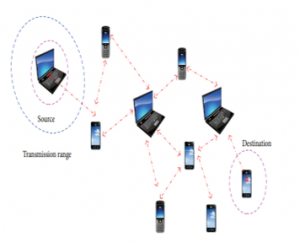
Figure 1: Example of a MANET network. Adapted from [8]
Description of various ways of signal transmission and data packet delivery in MANETs is conducted through examination of routing protocols [9]. Due to the abrupt, endless and unregulated participation in the network by the nodes, MANETs topological information is perpetually changing. This constant change of topological information of nodes in MANETs is considered as one of the hindrances to the possible reliability and security. Different and new nodes are included or excluded from the network. However, the efficacy of packets and the signal broadcast inside a network is primarily reliant on the routing protocol selection [9]. A routing protocol in MANET decides on the utmost proficient route from the source node to the destination node.
Categorization of routing protocols in MANETs is carried out through various methods. Generally, the topological information of network is used in categorizing a routing protocol as either reactive or proactive. On the other hand, the plan, strategy or the general design of a MANET communication applied during signal and data packet transmission may result to either multicast, broadcast, or unicast routing [10]. Moreover, MANETs routing can be categorized into groups that depend on routing network topological tables or into groups that require route request from a source to initiate routing [11]. However, some studies suggest that this classification is arrived at through application of routing strategy.
The structure of the network is another method applicable in the classification of MANETs routing protocols. Classifying of routing protocols on network structure, generally, three classes are derived. That is, the group of routing that is aided by geographic information, flat routing and hierarchical routing. Network topological routing table dependent and the source node route discovery routing protocols are included in flat routing. On the other hand, routing protocols in MANETs mainly lie in either proactive, reactive and or hybrid categories [11].
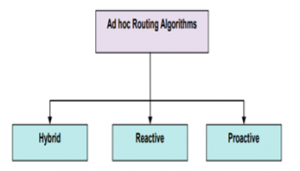
Figure 2: Routing protocols groupings in MANETs based on design philosophy [11].
Network topological routing tables maintain the network information on routing over the connectedness period. However, the topological routing information maintained by proactive routing protocols are not used constantly during the network’s state of connectedness. Because MANETs connect on peer-to-peer basis, every mobile node in a proactive network maintains routing information of the neighboring devices. Proactive protocols rely on network topological routing tables to accumulate and maintain routing data on every neighboring mobile node.
One of the shortcomings of table-driven routing is the need to occasionally update according to the constant and abrupt inclusion and exclusion of mobile nodes. MANETs nodes signal and data packets propagation derive its guidelines from the link state of nodes. Therefore, a signal propagation and routing procedure is established through routing information as stored and maintained in a network topological routing table. Furthermore, proactive routing protocols can be made up of more than one type of data in a routing table [12]. For example, a routing table may contain the nodal-zonal information or the link-state of a mobile device/node.
Because table-driven routing protocols preserve routing statistics of every mobile node, they are wasteful and unfitting for use in highly interconnected ad hoc networks. But, if table-dependent protocol is used in a highly interconnected network, the routing information available for storage and maintenance may exceed the capacity of routing tables. Consequently, this may lead into additional overhead of more power consumption. Oppositely, reactive routing protocols avoid holding onto routing information—topological, of nodes in routing tables. Similarly, reactive protocols do not maintain network events in tables. Reactive protocols initiate routing process on request by the source nodes. During the on-demand event, the concerned nodes articulate the most efficient routes in a network. Reactive routing transmits data and the related signals as requested by other nodes. However, lack of routing network topological tables in reactive routing may require route flooding during route discovery process [12].
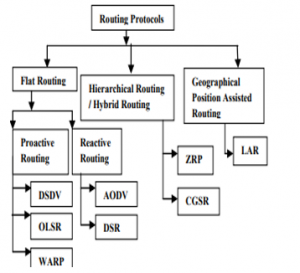
Figure 3: Classification of MANET Routing [12]
In hybrid routing protocols, the operational design and capabilities of proactive and reactive routing are unified to maximize effectiveness. Because hybrid routing is designed to minimize routing overhead—such as power consumption, they are mostly deployed in large networks. Routing overhead results from the systematic topological data apprises and maintenance in the routing tables. Besides, hybrid routing minimizes data packet delivery delay in table-driven (reactive) routing protocols [13]. Latency results from route discovery procedure initiated in the reactive part of hybrid routing. Over period of time, latency reduces the overall number of data packets delivery per unit.
In Zone Routing Protocol (ZRP), zones—determined through hops, are composed of nodes whose location is defined by the maximum size of the radius. Zones in ZRP can be conceptualized as small networks within larger networks. The radius of a subnetwork is determined by the number of hops. For example, a radius of two is equivalent to the zone whose maximum hops are 2. Because ZRP uses hybrid routing, it utilizes operational technicalities of both proactive and reactive routing. A local zone uses table driven (proactive routing), while nodes outside local zones use reactive routing. Local zones use proactive routing protocols for speedy transmission of signals and data packets among nodes. To minimize possible overhead, ZRP uses reactive routing for interzonal transmissions [14].
Since DSDV is a table-drive (proactive) routing protocol, it relies on network topological routing tables to store and preserve the network information [15]. Mobile nodes in DSDV uphold routing tables containing topological information and data of the network. These routing tables maintain information on addresses, the number and subsequent hops to destination node, and the sequence assigned to the various nodes—particularly, the destination node. DSDV uses the concept of Routing Information Protocol (RIP). In RIP, each node carries routing tables whose routing information includes probable end points of communications(messages) and the hop quantity vital in enabling transmission of the messages in the ad hoc network. Another trait of DSDV is distance vector routing. That is, it utilizes bidirectional links. A key short coming of DSDV is its limitation to utilize one/single route in internodal communications.
Greedy Perimeter Stateless Routing (GPSR) protocol relies on location information of nodes during route discovery. In GPSR, forwarding a packet is built on the known position of the routers/source node and the destination node. It a “novel routing protocol for wireless datagram networks that uses the positions of routers and a packet’s destination to make packet forwarding decisions” [15, p.5]. The information stored in topological routing tables is utilized in greedy propagation of data throughout the nodes in ad hoc network. Upon reaching the limit of greedy transmission, GPSR uses a set of rules (algorithm) to traverse the limits of the network.
Notably, with the increase in the quantity of destination nodes, GPSR “scales better in per-router state than shortest-path and ad-hoc routing protocols” [15, p.1) because it only maintains the topological link state the local topology in a network. Since Manets are dynamic—mobile nodes are autonomous to either join or leave the network, their topologies are subject to variations. But, GPSR handles this topological dynamism and its effects through exploitation of the local network topological data for route discovery. Mostly, GPSR is appropriate require highly connected/dense networks.
Apparently, all MANETs routing protocols are unique in their algorithmic composition. However, virtually all performance comparative studies evaluate these routing protocols on general terms without ascribing the variations of their performance to any exact algorithmic feature. With such generality, it becomes problematic to use them for routing selection by the network engineers and administrators. Moreover, it becomes difficult to use such studies for future MANETs routing designs. For this reason, it is critical that comparative performance analysis grounded on particularity of these unique algorithmic foundations. The research question of this study is:
- What algorithmic elements attributable to variations in performances of selected MANETs routing protocols?
2. Theoretical Background
Performance comparison studies of MANETs routing protocols are not new. However, majority of these studies conduct performance analysis in general, without pinpointing to specific possible algorithmic aspects that affects variations in performance. For instance, study [16] compares the general performance of Dynamic Source Routing (DSR), Ad hoc on demand distance Vector Routing (AODV), and Destination Sequenced Distance Vector (DSDV) to establish the effectiveness of each of the protocols. Study [16] measures packet delivery ratio, average throughput, average end-to-end delay, and packet loss ratio based on nodes as the variable.
Likewise, paper [17] studies ad hoc on demand distance vector (AODV), dynamic source routing (DSR), and destination-sequenced distance vector (DSDV) routing protocols by means of various parameters of Quality of Service (QoS). These metrics include packet delivery ratio (PDR), normalize routing overhead, throughput, and jitter. The study aimed to establish the difference in performance of the listed protocols. Characterization of the simulation scenario in this study was based on parameters depicting large-area MANET with high-speed mobile nodes. Simulation results are thereafter analyzed through AWK and Xgraph.
Meanwhile, study [18] compares the performance of three routing protocols—DSDV, DSR and AODV. Finally, the paper presents the overall properties and performance of these protocol. Markedly, however, the study is not clear on the significance and types of parameters simulated or analyzed. Other works such as [19], uses literature review to compare various protocols on the basis of some selected performance metrics such as scalability, overhead, reliability. In this study, however, the tools of research or study are not clear. Additionally, the criteria for selecting routing protocols for analysis is not clearly indicated.
Paper [20] comprehensively compares AODV, DSR and OLSR on a real-word scenario—office. The study compares the routing protocols in three probable situations (based on mobility) via UDP, Ping and TCP traffic. The study also tries to determine their comparative performance variation among simulation, emulation and the real world. Matching protocol employments applied in each of the environments. A key shortcoming of this paper is its failure to highlight the reasons behind the selection of study and comparison routing metrics. As such, this disadvantage diminishes the contribution of this study. Other performance based comparative studies include [21] that presents comparison of the prevalent broadcast-based MANETs routing protocols. The study examines the performance of Dynamic Source Routing (DSR)—IEEE 802.11 standard based protocol, on performance metric parameters of throughput, end-to-end packet delay, jitter and salvaged packets using. Performance evaluation was done on QualNet 5.0.2 network simulator.
Studies such as [22] evaluates and compares the performance DSDV, AODV and DSR. It bases the examination on metrics of throughput, packet delivery ratio and average end-to-end delay simulated NS-2. However, the paper fails to present a detailed case where either a single trait or a group of routing characteristics are pinpointed based on their effects on the presented performance. Similarly, studies [23]-[30] conducted various analysis on basic and common metrics such as data packet delivery ratio, general packet outputs, delays and latency. A key limitation of these studies is the lack of precision on routing protocol selection methodology and the lack of specificity on effects of various characteristics of the compared routing protocols. Consequently, it is challenging to attribute the differences in performance to any particular characteristic or principle of the routing protocols.
3. Study Methodology
To identify and select the MANETs routing protocols to be evaluated, this study used purposive sampling method. A purposive sample is also called judgmental or expert sample [31]. It is non- probabilistic in its approach to sampling. The core goal of a purposive sampling is to obtain a sample that is a reasonable representative of the population. To select the routing protocols to study and compare, this study used the following criteria;
- Zone Routing Protocol (ZRP) represents hybrid routing protocols
- Ad hoc On-Demand Distance Vector routing (AODV) represents reactive routing protocols.
- Destination-Sequenced Distance Vector routing (DSDV) represents proactive routing
- while Greedy Perimeter Stateless Routing (GPSR) represents location-based routing protocols
Review of the selected routing protocols followed the steps outline in [32]. Before simulation, we formulated the following research questions from pre-liminary review of the existing studies on MANETs routing protocols.
- How are current comparative performance studies in MANETs limited?
- What is the general approach in MANETs routing protocols comparative performance studies?
Identification of answers to the above questions was followed by critical analysis and evaluation of the current studies on MANETs routing protocol comparative performance. Literature review and analysis suggests that the current studies do not try to associate certain traits of routing protocols to differences in performance. The following research questions cannot be answered by the current studies:
- What algorithmic aspects of the routing protocols that could possibly cause the differences in performances?
- What is attributable to the differences in performance in MANETs routing protocols?
Without an answer to the above research questions, it introduces generality that is not helpful in future designs of MANETs routing protocols. Additionally, without answers to above questions, it becomes challenging for network engineers and administrators to select the appropriate routing for given scenarios.
Figure 4: Literature Review and Analysis Steps [32]
After selection of the above listed routing protocols, both NS-2 and OMNET++ was used for simulation. NS2 was used to simulate ZRP while AODV, DSDV and GPSR were simulated on OMNET++. Simulation data from the two simulators was analyzed on RapidMiner. General review of literature followed the steps outlined in [32].
4. Results and Discussion
Metrics on data packets received, latency, drop rates and throughput of packets relating to ZRP were obtained from NS2 simulator while OMNET++ was used to generated simulation data for AODV, DSDV and GPSR. It should be clear that this study seeks only to analyze the effects of algorithmic nodal position information in selected MANETs routing protocols and not to a comprehensive study of performances under combinations of various parameters. Indeed, this study seeks to examine the inclusion of algorithmic location information at basic level. Notable from the parameter table 2 is the lack of various common parameters necessary for comprehensive performance analysis in MANETs routing protocols.
This has been done through design because the purpose of this study is to uses basic parameters to determine the algorithmic elements of initiating performance variations in selected routing protocols. For example, this study leaves out jitter, power and simulation node density.
Table 1: Preliminary parameters
| Parameter | Metric |
| Quantity of simulation nodes (x) | 100 |
| Simulation Area (a) | 500m*500m |
| Simulation Packet Size (p) | 512 bytes |
| Simulation time (t) | 1000s |
| Simulations(n) | 50 |
Data packets received refers to the packets difference between the quantity sent and the quantity lost. Data packets successfully transmitted is entire amount of data packets that effectively reaches the intended destination node over the period of simulation. Data packets transmitted from the source node comprise of the packets sent. This fractional metric is created on the count of Constant Bit Rate (CBR) from the source node to the destination. To calculate the metric for the packets delivery ratio (PDR), the following formula is used:
However, the aim of this study was not to conduct a general performance analysis, but rather, basic examination of algorithmic code on the selected MANETs routing protocols. Packet Delivery Ratio, however, shows the relationship between the data packets received successfully and the packets sent. A low count of packets received results to a lower PDR and indication of a big loss across the network. A big packet loss may suggest a possible technical problem in the network layer. Low PDR may also suggest a reduced normalized routing load (NRL), which measures the ratio between data packets delivered successfully and the original quantity of data transmitted.
Nonetheless, this study is not designed to conduct a substantive analysis of comparative performance but rather to answer the following research question:
- What algorithmic aspect of the selected routing protocols is attributable to difference in performance?
Table 1 and figure 1 show the variation in the quantity of data packets successfully transmitted from a source node to the destination. From the table and the figure, it is evident enough that, however small in variation, GPSR steadily outperforms ZRP, DSDV, and AODV. Algorithmically, DSDV and AODV use hops to determine a route from the source node to the destination node. Despite DSDV depending on network topological tables to initiate routing process, it steadily outperforms AODV which depends on queries from source nodes to initiate routing. This could be attributable to the algorithmic element to constant update network topological tables, hence faster access to route information. Easily accessible route information speeds up the routing process. The constant updates of routing tables by may utilize more power in the form of overhead, but this pays off in form of augmented routing efficiency.
Moreover, ZRP—a hybrid protocol, seems to outperform both DSDV and AODV. This variation in routing performance can be credited to its utilization of algorithmic operational qualities in both AODV and DSDV. That is, its algorithmic properties to combine proactive and reactive routing features. Conspicuous in the table 1 and figure 1 is the abrupt improved performance of GPSR at around 700th second of simulation. Consequently, the usage of nodal location as key determinant of routes in GPSR seems to outperform other selected routing protocols. But this phenomenon appears to exemplify with simulation time. One implication of such a routing behavior is dependability. Evidently, figure 1 indicates that inclusion of nodal location information can be dependable network stabilizer, thus enhancing its dependability. In this case, for example, it is plausible for a network engineer or administrator to suggest deployment of GSPR in a military or rescue operations because they all demand stable and dependable networks.
Because distance vector routing protocols determine best routes on relative distance—hops, AODV and DSDV appear to be efficient but relatively unreliable for networks that require stability. ZRP on the other hand, seems relatively less reliable to GPSR. Although distance vector routing algorithm decides on best routing paths on basis of fewest hops, they are unstable and unreliable compared to location-assisted and hybrid routing.
Table 2: A Summary of Data Packets Successfully in Selected Routing Protocols.
| GPSR | ZRP | DSDV | AODV | Time in Seconds |
| 9254 | 9100 | 9000 | 8500 | 100 |
| 8951 | 8793 | 8695 | 8650 | 200 |
| 10861 | 10733 | 10620 | 10531 | 300 |
| 11064 | 10937 | 10848 | 10788 | 400 |
| 12584 | 13637 | 12193 | 11926 | 500 |
| 13502 | 13111 | 13099 | 14000 | 600 |
| 14302 | 14150 | 13973 | 13600 | 700 |
| 13064 | 11941 | 9491 | 10267 | 800 |
| 12584 | 12391 | 10321 | 11927 | 900 |
| 12987 | 11926 | 11871 | 11876 | 1000 |
Visible in figure 5 is the trend that packets delivery is growing steadily with time. Particularly, on average, GPSR has more packets delivered from the source to the destination while experiencing least packet loss. Exhibiting better performance in comparison to the other two protocols—DSDV and AODV, is ZRP. One of the possible causes of this better performance can be attributed to presence of location-position data in the routing tables of a nodes in GPSR. With such information, possible flooding of nodes is avoided during route discovery process. Flooding avoidance in IERP could also be associated to its second-best data delivery.
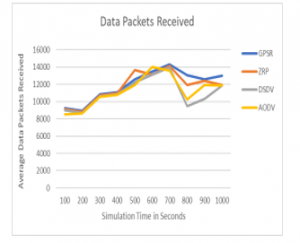
Figure 5: Data Packets Received Successfully in Selected Routing Protocols
Average delay determines the average time take by a single data packet from the source node to the destination node. Data packet delivery delay can be caused by route discovery process, broadcasting/transmission buffer, retransmission requests, or general signal latency. High delay time is an indication of inefficiency in the network layer—as outlined in OSI model. Highly delay can be caused by factors such as network congestions or low network transmission capacity among other reasons. Average delay is derived from subtracting Packet Send Time (PST) from Packet Receive Time (PRT), then divide it by the successfully received packets. Packet Transmission Delay (PTD) metric is calculable by using the following formula:

Table 3 and figure 3 represent average delay results as recorded from the simulation of the selected routing protocols. Delay in GPSR seems to be lowest among the selected routing protocols. Perhaps, inclusion of nodal location information element in its routing algorithm speeds up route discovery process. Delay in GPSR seems to start comparatively high but reduces with time. This is explaining why GPSR, comparatively, takes longer to outpace other selected routing protocols. Similarly, ZRP begins on a relatively higher delay but makes up the ground with simulation time. Delay dormancy in both of these routing protocols—GPSR and ZRP, is attributable to their uniquely algorithmic routing features compared to the other selected routing protocols.
As GPSR and ZRP minimize delay with simulation time, AODV and DSDV begin to increase their delay. Since AODV and DSDV use hops—however differently, to determine the best paths, their initial low delay can be attributed to average distances of adjacent/neighboring mobile nodes. Initial low delay suggests high reachability of the neighboring nodes, while high delay indicates low reachability of nodes further away from the source node. High delay at the beginning simulation in ZRP points to an existence of complexity as a result of combining two mutually exclusive algorithmic features—reactive and proactive routing elements. Similarly, GPSR introduces complexity in the initial stages due to location calculation. The following formulas determine the location —distance and angular location, information in GPSR respectively.

Table 3: Average Delay across Selected Routing Protocols
| GPSR | ZRP | DSDV | AODV | Time in Seconds |
| 0.098 | 0.099 | 0.0119 | 0.0125 | 100 |
| 0.087 | 0.092 | 0.0108 | 0.0121 | 200 |
| 0.068 | 0.073 | 0.081 | 0.095 | 300 |
| 0.045 | 0.051 | 0.062 | 0.072 | 400 |
| 0.019 | 0.021 | 0.031 | 0.043 | 500 |
| 0.06 | 0.067 | 0.073 | 0.089 | 600 |
| 0.055 | 0.059 | 0.064 | 0.071 | 700 |
| 0.068 | 0.074 | 0.074 | 0.078 | 800 |
| 0.045 | 0.059 | 0.069 | 0.072 | 900 |
| 0.019 | 0.041 | 0.035 | 0.069 | 1000 |
In figure 4, GPSR consistently outperforms ZRP, DSDV and OADV in average delay of packet delivery. Although, generally the packets delay in all four routing protocols decrease overtime, delay in GPSR declines the most. A key deduction from this metric—packet delivery delay, is that MANETs routing protocols utilizing the position-location information reduces flooding and overlapping of zones, thus achieving overall better performance over a period of time. This holds true for packets drop rate and packets throughput as manifested in figures 7 and 8, respectively.
Packets dropped during transmission represent the lost packets during routing. Table 4 and figure 7 show that comparatively, GPSR has a slight edge in the number of packets dropped during routing. Generally, however, all other three selected routing protocols significantly experience reduced packets drop rates over the course of simulation period. Lower packets drop rates in GPSR can be ascribed to availability of location information of destination nodes. Location information increases precision of location of network nodes—despite their movements within a network. This means that GPSR, unlike the other three selected routing protocols, constantly calculates the locations of its network nodes. Equipped with nodal location data, GPSR is able to propagate data packets with more precision than other selected routing protocols.
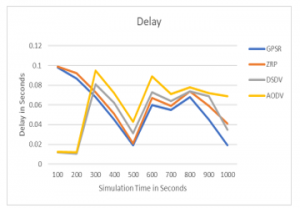
Figure 6: Packets Delay
Dropped or lost data packets can be calculated by subtracting the number of packets successfully transmitted from the number of data packets successfully received, then divided by the transmission time. The following formula is applicable:

Table 4: Packets Drop Rates in Selected Routing Protocols
| GPSR | ZRP | DSDV | AODV | |
| 5326 | 5339 | 5438 | 5531 | 100 |
| 6784 | 6869 | 6912 | 6954 | 200 |
| 4586 | 4625 | 4735 | 4891 | 300 |
| 3400 | 3981 | 3999 | 4103 | 400 |
| 1105 | 1230 | 1421 | 1531 | 500 |
| 627 | 936 | 999 | 1023 | 600 |
| 521 | 950 | 962 | 964 | 700 |
| 625 | 1020 | 1025 | 1037 | 800 |
| 500 | 925 | 947 | 981 | 900 |
| 607 | 890 | 903 | 955 | 1000 |
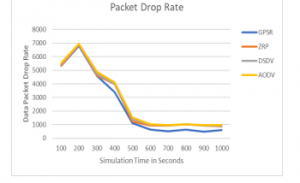
Figure 7: Packets Drop Rate
Table 5: Packets Throughput Across Selected Routing Protocols
| GPSR | ZRP | DSDV | AODV | |
| 13624.01 | 13523 | 13267 | 12348 | 100 |
| 14215.32 | 13181 | 13080 | 12670 | 200 |
| 14832.97 | 14735 | 14621 | 14210 | 300 |
| 15462.76 | 15371 | 15213 | 15104 | 400 |
| 18952.85 | 17731 | 17512 | 17111 | 500 |
| 18108 | 18000 | 17836 | 17000 | 600 |
| 18321 | 17900 | 17520 | 17390 | 700 |
| 19001 | 18273 | 18040 | 17900 | 800 |
| 15000 | 17671 | 9439 | 9100 | 900 |
| 19000 | 17943 | 17391 | 16890 | 1000 |
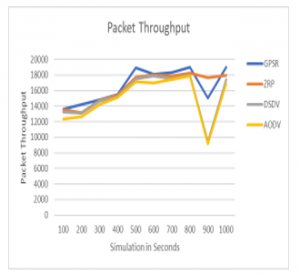
Figure 8: Packets Throughput
5. Conclusion and Further Recommendations
Comparative performance studies on MANETs routing is one of the highly examines areas of networking. A keen enquiry, however, reveals that majority of performance analysis research works are very general. Absence of provenance to exclusive algorithmic elements in MANETs routing protocols make hard for network engineers and administrators to develop, select and implement routing. Moreover, such studies fail to make significant contributions vital in future design, development and implementation of MANETs routing.
This study attempts to investigate the effects of various unique algorithmic elements in selected MANETs routing protocols. Through purposive sampling, systematic literature review and simulation tools and analysis (NS2, OMENT++ and RapidMiner), we strive to associate variations in MANETs performances to identified algorithmic elements such position-location nodal topological information.
However, we must note that this study is basic in its approach. For instance, we left out critical parameters during simulation. This was done purposely to delimit the research to its topic variables. By simulating these purposively selected MANETs routing protocols—GPSR, ZRP, DSDV, AODV, the results suggest that GPSR, over time, outperforms the selected MANETs routing protocols on: data packets delivery, delay and overall throughput. Better performance of GPSR could be, generally, attributed to its use of algorithmic nodal location-position information elements.
However, this study used time (fixed at 1000 seconds) as variable metric for simulation. Consequently, it is suggested that further simulations be conducted on composite variables of number of nodes. Using number of nodes as the basis (variable factor) for investigation, can reveal the most effective MANETs routing protocols for small, medium and large networks.
Conflict of interest
The authors declare that there is no conflict of interests in relation to the publication of this paper.
- P. Manickam, T. Guru Baskar, M. Girija and D. Manimegalai, “Performance Comparisons of Routing Protocols in Mobile Ad Hoc Networks”, International Journal of Wireless & Mobile Net-works, vol. 3, no.1,pp.98-106,2011.Available:10.5121/ijwmn.2011.3109[Accessed14April 2020].
- M. Kassim, R. Ab. Rahman and R. Mustapha, “Mobile ad hoc network (MANET) routing protocols comparison for wireless sen-sor network”, 2011 IEEE International Conference on System En-gineering and Technology, 2011.Available: 10.1109/icsengt.2011.5993439[Accessed 14 April 2020].
- R. Ferdous and V. Muthukkumarasamy, “A Comparative Perfor-mance Analysis of MANETs Routing Protocols in Trust-Based Models”, 2016 InternationalConference on Computational Science and Computational Intelligence (CSCI), 2016. Available: 10.1109/csci.2016.0171 [Accessed 14 April 2020].
- K. Zaini, A. Monzer Habbal, F. Azzali and M. Abdul Rejab, “Comparative Study on the Performance of TFRC over AODV and DSDV Routing Proto cols”, Software Engineering and Computer Systems, pp.398-407, 2011. Available: 10.1007/978-3-642-22203-0_35 [Accessed 14 April 2020].
- P. Nand and S. Sharma, “Comparison of Routing Pro tocols for MANET and Performance Analysis of DSR Proto-col”, Communications in Computer and Information Science, pp. 406-412,2011. Available: 10.1007/978-3-642-18440-6_52 [Accessed 14 April 2020].
- D. Ismail and M. Ja’afar, “Mobile ad hoc network over-view”, 2007 Asia-Pacific Conference on Ap plied Electromag-netics, 2007. Available: 10.1109/apace.2007.4603864 [Accessed 16February 2020].
- S. Meshram and P. Dorge, “Design and performance analysis of mobile Ad hoc network with reactive routing protocols”, 2017 In-ternational Conference on Communication and Signal Processing (ICCSP), 2017. Available: 10.1109/iccsp.2017.8286396 [Ac-cessed 16 February 2020].
- S. Omari and P. Sumari, “An Overview of Mobile Ad Hoc Net-works for the Existing Protocols and Applica-tions”, International Journal on Applications of Graph Theory in Wireless Ad HocNetworks and Sensor Networks, vol. 2, no. 1, pp. 87-110, 2010. Available: 10.5121/jgraphhoc.2010.2107 [Ac-cessed 16 February 2020].
- L. Cai, J. Pan, X. Shen and J. Mark, “Peer Collaboration in Wire-less Ad Hoc Networks”, NETWORKING 2005. Networking Technologies, Services, and Protocols;Performance of Computer and Communication Networks; Mobile and Wireless Communica-tions Systems, pp. 840-852, 2005. Available: 10.1007/11422778_68 [Accessed 16 February 2020].
- A. Veerasamy, S. Madane, K. Sivakumar and A. Sivaraman, “An-gle and Context Free Grammar Based Precarious Node Detection and Secure Data Transmission in MANETs”, The Scientific World Journal,vol. 2016, pp. 1-12, 2016. Available: 10.1155/2016/3596345 [Accessed 16 February 2020].
- S. Omari and P. Sumari, “An Overview of Mobile Ad Hoc Net-works for the Existing Protocols and Applica-tions”, International Journal on Applications of Graph Theory In Wireless Ad Hoc Networks And sensor Networks, vol.2, no.1, pp. 87 110,2010.Available: 10.5121/jgraphhoc.2010.2107 [Accessed 16 February 2020].
- R. Thiagarajan and M. Moorthi, “Efficient routing protocols for mobile ad hoc network”, 2017 Third International Conference on Advances in Electrical, Electronics, Information, Communication and Bio-Informatics (AEEICB), 2017. Available: 10.1109/aeeicb.2017.7972346 [Accessed 16 February 2020].
- H. Moudni, M. Er-rouidi, H. Mouncif and B. Hadadi, “Secure routing protocols for mobile ad hoc net works”, 2016 Inter-national Conference on Infor mation Technology for Organ-izations Development (IT4OD), 2016. Available: 10.1109/it4od.2016.7479295 [Accessed 16 February 2020].
- N. Saudi, M. Arshad, A. Buja, A. Fadzil and R. Saidi, “Mobile Ad-Hoc Network (MANET) Routing Protocols: A Performance As-sessment”, Proceedings of the Third International Conference on Computing, Mathematics and Statistics (iCMS2017), pp. 53-59, 2019. Available: 10.1007/978-981-13-72797_7 [Accessed 16 February 2020].
- M. Ichaba, “Examining Possible Supplementary Nature of Routing Protocols in Mobile Ad-hoc Networks (MANETs): A Discus-sion”, OMICS Online, vol. 09, no. 03, 2018. Available: 10.4172/2229-8711.1000229 [Accessed 16 February 2020].
- T. Feiroz Khan and D. Sivakumar, “Performance of AODV, DSDV and DSR protocols in mobile wireless mesh networks”, Second In-ternational Conference on Current Trends In Engineering and Technology – ICCTET 2014, 2014. Available: 10.1109/icctet.2014.6966324 [Accessed 16 February 2020]. [Ac cessed 16 February 2020].
- S. Ali and A. Ali, “Performance Analysis of AODV, DSR and OLSR in MANET”, Masters, Blekinge Institute of Technology, 2020.
- E. Cana, “Comparative Performance Simulation of DSDV AODV and DSR MANET Protocols in NS2”, International Journal of Business & Technology, vol. 2, no. 1, pp. 24-31, 2013. Available: 10.33107/ijbte.2013.2.1.4.
- M. Alslaim, H. Alaqel and S. Zaghloul, “A comparative study of MANET routing protocols”, The Third International Conference on e-Technologies and Networks for Development (ICeND2014), 2014. Available: 10.1109/icend.2014.6991375 [Accessed 16 February 2020].
- S. Mohapatra and P. Kanungo, “Performance analysis of AODV, DSR, OLSR and DSDV Routing Protocols using NS2 Simula-tor”, Procedia Engineering, vol. 30, pp. 69-76, 2012. Available: 10.1016/j.proeng.2012.01.835 [Accessed 16 February 2020].
- T. Devi, “IMPLEMENTATION OF DYNAMIC SOURCE ROUT-ING (DSR) IN MOBILE AD HOC NETWORK (MA-NET)”, International Journal of Research in Engineering and Technology, vol. 02, no. 11, pp. 339-345, 2013. Available: 10.15623/ijret.2013.0211053 [Accessed 16 February 2020].
- T. Devi, “IMPLEMENTATION OF DYNAMIC SOURCE ROUTING (DSR) IN MOBILE AD HOC NETWORK (MA-NET)”, International Journal of Research in Engineering and Technology, vol. 02, no. 11, pp. 339-345, 2013. Available: 10.15623/ijret.2013.0211053 [Accessed 16 February 2020].
- E. Mahdipour, A. Rahmani and E. Aminian, “Performance Evalua-tion of Destination-Sequenced Distance-Vector (DSDV) Routing Protocol”, 2009 International Conference on Future Networks, 2009. Available: 10.1109/icfn.2009.51 [Accessed 16 February 2020].
- M. Alslaim, H. Alaqel and S. Zaghloul, “A comparative study of MANET routing protocols”, The Third International Conference on e-Technologies and Networks for Development (ICeND2014), 2014. Available: 10.1109/icend.2014.6991375 [Accessed 16 February 2020].
- S. Goswami, S. Joardar, C. Das, S. Kar and D. Pal, “Performance Analysis of Three Routing Protocols in MANET Using the NS-2 and ANOVA Test with Varying Speed of Nodes”, Ad Hoc Net-works, 2017. Available: 10.5772/66521 [Accessed 16 February 2020].
- A. Alfa, S. Misra, A. Adewumi, F. Salami, R. Maskeli?nas and R. Damaševi?ius, “Implementation of MANETs Routing Protocols in WLANs Environment: Issues and Prospects”, Advances in Intelli-gent Systems and Computing, pp. 252-260, 2018. Available: 10.1007/978-3-319-74980-8_24 [Accessed 16 February 2020].
- D. Sudarsan, P. Mahalingam and G. Jisha, “Distance Aware Zone Routing Protocol for Less Delay Transmission and Efficient Bandwidth Utilization”, Advances in Intelligent Systems and Com-pu ting, pp. 63-71, 2012. Available: 10.1007/978-3-642-30111-7_7 [Accessed 16 February 2020].
- S. Shelly and A. Babu, “Link Reliability Based Greedy erimeter Stateless Routing for Vehicular Ad Hoc Networks”, International Journal of Vehicular Technology, vol. 2015, pp. 1-16, 2015. Available: 10.1155/2015/921414 [Accessed 16 February 2020].
- B. Karp and H. Kung, “GPSR”, Proceedings of the 6th annual international conference on Mobile omputing and networking – MobiCom ’00, 2000. Available: 10.1145/345910.345953
- S. Adam and R. Hassan, “Delay aware Reactive Routing Protocols for QoS in MANETs: a eview”, Journal of Applied Research and Technology, vol. 11, no. 6, pp. 844-850, 2013. Available: 10.1016/s1665-6423(13)71590-6 [Accessed 16 February 2020].
- H. Ames, C. Glenton and S. Lewin, “Purposive sampling in a qual-itative evidence synthesis: a worked example from a synthesis on parental perceptions of vaccination communication”, BMC Medical Research Methodology, vol. 19, no. 1, 2019. Available: 10.1186/s12874-019-0665-4 [Accessed 17 April 2020].
- L. Machi and B. McEvoy, The literature review, 2nd ed. Corwin, 2012.
Citations by Dimensions
Citations by PlumX
Google Scholar
Scopus
Crossref Citations
- Ahmed R Zarzoor, "Enhancing dynamic source routing (DSR) protocol performance based on link quality metrics." In 2021 International Seminar on Application for Technology of Information and Communication (iSemantic), pp. 17, 2021.
- M. Vargheese, Surbhi Bhatia, Shakila Basheer, Pankaj Dadheech, "Improved Multi-Path Routing for QoS on MANET." Computer Systems Science and Engineering, vol. 45, no. 3, pp. 2521, 2023.
No. of Downloads Per Month
No. of Downloads Per Country
